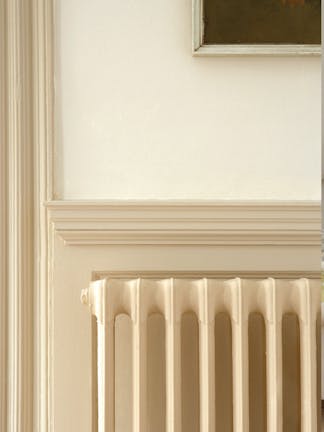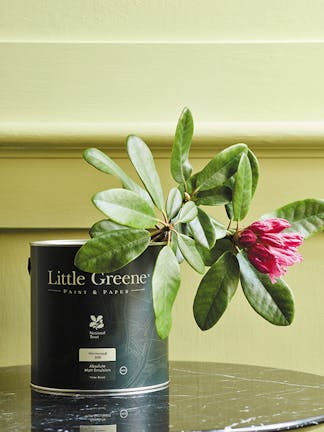When painting a room, radiators are often forgotten and painted white out of habit.
Considering radiator paint in your colour scheme will help you to create a coordinated finish. Highlight radiators with a contrasting colour or paint them in a complementary shade.
Where possible, we would advise painting your radiator before it is fitted; this will allow you to paint all surfaces. However if this isn’t possible, simply paint the radiator in situ. Make sure to drain the radiator and ensure it is turned off during the application process.
Choose a radiator paint finish

Intelligent Eggshell
Intelligent Eggshell is the perfect finish for radiators, it is formulated to resist moisture, staining and general wear and tear. Unlike all modern day solvent-based paints, our Intelligent paint finishes are heat-resistant and guaranteed not to yellow upon exposure to high temperatures.
Intelligent Eggshell has a tough yet subtle finish and is a superb paint for woodwork and metalwork.
Its soft low sheen is:
- Environmentally-friendly
- Water-based
- Fully washable
- Suitable for most surfaces including walls, woodwork and primed metals such as radiators and radiator pipes
- Certified completely safe for children's rooms and furniture ('Toy Paint Regulations' EN 71-3:2019)
- Gloss level - 15% (low)
- Covers approximately 570 square feet per US gallon (one coat)
- Available in all colours
- Available in 2 tin sizes: quart and gallon

How to paint a radiator
Prepare the surface
Before beginning the project, place protective dust sheets under the radiator to protect your flooring.
For previously painted radiators, smooth the surface with a medium grade sandpaper. This will create a slightly rough surface that the paint will adhere to. Following this, thoroughly clean your radiator surface with a sponge and sugar soap before rinsing and allowing to dry.
Prime the metalwork
It is vital to prime your radiator, to prevent staining and rust spots that could alter your chosen colour.
Ensure that you have properly stirred the paint prior to commencing painting. Using an angled paint brush, apply two coats of Intelligent ASP (All Surface Primer) to prime the surface and acheive full depth of colour.

Paint the radiator
Leave the undercoat to dry for 4 hours before applying the first coat of paint in your chosen shade. We recommend using Intelligent Eggshell as an easy-to-use, quick-drying radiator paint.
(Note: This type of paint can be thinned as applied as a spray paint if desired. See the detailed Product Data Sheets for further guidance.)
Allow 4 hours for the first coat to dry before applying the second and final coat. For deep hues, you may need to apply an extra coat for the perfect finish. Allow the paint to dry fully for 48 hours before turning on the radiator.

As with most painting projects, preparation is important and will make a difference between a beautiful professional finish and a botched job.
When you're choosing a colour to paint your radiator, bear in mind the surroundings. You can reduce the prominence of a radiator by using the same colour as the walls or make a statement but using a contrasting or complimentary colour.
It is ideal if you can paint your radiator before it is plumbed in - or if you can take it down. This allows you to get better coverage on the hard to reach areas - but be careful if it's already plumbed in - you'll need to drain the radiator first - so it might not be the best option if you've got a new carpet!
If you're painting your radiator in situ, then make sure you keep it turned off until the paint has dried and ensure the room is well ventilated. Cover the surrounding area, and tape any areas which meets a surface you don't intend to paint over.

Use a piece of medium grade sandpaper to smooth the surface. If you have thick, unsightly paint or drip marks from a previous paint job, you may need to use a paint stripper to get a smooth finish.
Clean the radiator to get rid of any dirt, dust and fluff - anything like this trapped under a new coat of paint will be very noticeable, so it's worth the effort.
If your radiator has not been painted before, or has chips or wear which reveal the metal work underneath, you will need to use an oil-based undercoat or metal primer. A standard undercoat or primer won't prevent cracking or discolouration, but an anti-corrosive primer like Little Greene All Surface Primer applied to bare metal areas will help to prevent rust re-occurring - this is particularly important with a radiator because it will get very hot in use.

Radiator Painting Tips
- If you can see any rust, treat it before you apply the primer. If there is only slight surface rust, you should be able to get rid of it with sandpaper, but if there is a lot of rust visible, you would be better replacing the radiator.
- Stir your paint well before you start.
- To paint the radiator, a standard paint brush will do the job, but you might find it easier with a radiator paint brush - this is angled so you can get into awkward places.
- Avoid painting nuts and bolts or any moving parts, or you will have problems in future.
- You will usually need 2 coats over a primer for a nice finish.
- Leave at least 4 hours between coats for Intelligent Eggshell
Browse our full colour palette in Intelligent Eggshell for radiators.
If you’re struggling with selecting shades or concerned about colour combinations, Little Greene Colour Consultants can help you decorate your home with confidence.

